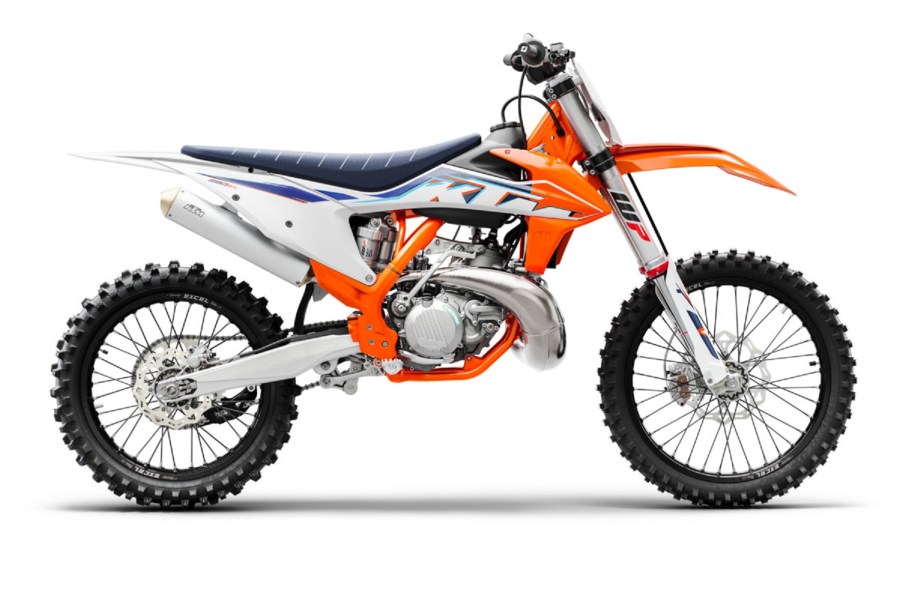
What’s the Difference Between 4-Stroke and 2-Stroke Dirt Bikes?
There’s a lot that goes into buying a dirt bike, whether it’s your first one or your 37th. However, there’s another wrinkle with these motorcycles besides knowing what specific type you’re after. Unlike other motorcycle segments, dirt bikes offer an alternative to the 4-stroke combustion engine besides going electric: the 2-stroke engine. So, if you’re stuck between the two, which should you pick?
2-stroke dirt bikes are literally built differently than 4-stroke ones

At first glance, a 2-stroke dirt bike looks identical to a 4-stroke one. The most external significant difference is that 2-strokes have noticeably larger exhaust headers. But it’s not a stylistic affectation, RevZilla explains. It’s just one of the more obvious ways that 2-stroke motorcycles differ from 4-stroke ones.
Fundamentally, 2-stroke and 4-stroke dirt bikes operate according to the same gasoline-powered internal-combustion principles. As the piston descends, it creates a vacuum, sucking air and fuel into the combustion chamber. The piston then ascends, compressing the mixture, which the spark plug then ignites. The resulting explosion forces the piston down—thus generating power—and on its return up-stroke, it forces the spent gases out.
But while 4-stroke bikes need four piston strokes—hence the name—to do this, 2-stroke motorcycles do it in two. In other words, they combine intake and compression into one step and combustion and exhaust into another. So, while a 4-stroke engine only makes power every four strokes, a 2-stroke one makes it every other stroke. And that requires significant changes to the engine’s construction.

For one, 2-stroke dirt bikes don’t have valves or camshafts. Instead, they have two permanently-open ports and the piston acts as a controlling valve. However, the inlet port has a reed valve to let air and fuel in but not out. And that’s why 2-stroke exhaust headers are shaped like they are—to maximize intake and exhaust efficiency.
Furthermore, because 2-stroke engines combine the intake and compression steps, they must use their crankcases as part of their intakes. So, their crankcases aren’t bathed in oil like 4-stroke ones. Therefore, 2-stroke dirt bikes need their fuel to have some oil mixed in. And because they burn oil and gasoline at the same time, 2-strokes have a distinctive smell.
4-stroke vs 2-stroke dirt bikes: the ‘better choice’ depends on what you’re after
These fundamental differences between 2-stroke and 4-stroke dirt bikes mean these bikes behave significantly differently. And it also means that they have different maintenance needs and schedules.
Because 2-strokes make power every other stroke, they make significantly more horsepower per liter than 4-strokes. These engines also respond faster than 4-stroke ones due to the shortened cycles, The Drive notes. Also, 2-stroke dirt bikes don’t experience the same level of engine-braking as 4-stroke ones.
However, while 2-strokes have higher specific outputs, their powerbands are narrow and higher in the rev range. So, getting the most out of these dirt bikes means a lot of careful-minded shifting, Dirt Rider explains. And even at lower RPMs, they tend to vibrate and buzz more. Also, it’s easier for riders to lose traction in the dirt on 2-stroke bikes than 4-stroke ones.
2-strokes’ simplicity similarly has its pros and cons. On the one hand, because they lack valvetrains, these bikes are lighter, nimbler, and have fewer maintenance needs. But they also put more strain on their remaining engine components, so their maintenance schedules are significantly shorter, even compared to 4-stroke motorcycles. So, you won’t be adjusting valves, but you will be replacing pistons and piston rings.
Finally, there’s the oiling issue. 2-stroke dirt bike riders need to pre-mix their oil and fuel so their engines stay cool and lubricated. Modern transfer-port-injected (TPI) bikes with their separate oil reservoirs make this less of a hassle, RevZilla notes, but they still require you to bring along oil bottles on longer rides. And TPI is only available on fuel-injected motorcycles, so those with carbureted bikes are stuck pre-mixing.
If you want a road-legal motorcycle, there’s only one choice
However, there’s another downside to pre-mixing oil and fuel besides taking up time and potentially causing a mess. Although gasoline combustion isn’t exactly 100% clean, it’s significantly cleaner than burning gasoline and oil concurrently. 2-stroke engines emit far more emissions than 4-stroke ones, including unburned gas, RevZilla reports. And that’s a problem not just for the environment, but for 2-stroke owners.
Admittedly, running a 2-stroke leaf blower or lawnmower isn’t a significant issue. Well, at least for those living outside of California. However, with motorcycles, it’s a different story. While there are some 4-stroke dirt bikes that aren’t street-legal, there are no street-legal 2-stroke models. These bikes simply can’t meet emissions requirements.
So, if you’re looking for a dirt bike that you can ride on- and off-road, you can’t pick a 2-stroke model. But if you just want an off-road machine, know that 2-strokes aren’t inherently better or worse than 4-strokes. They’re just better at different things.
Follow more updates from MotorBiscuit on our Facebook page.


